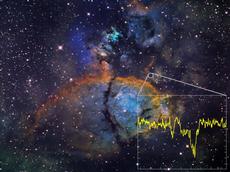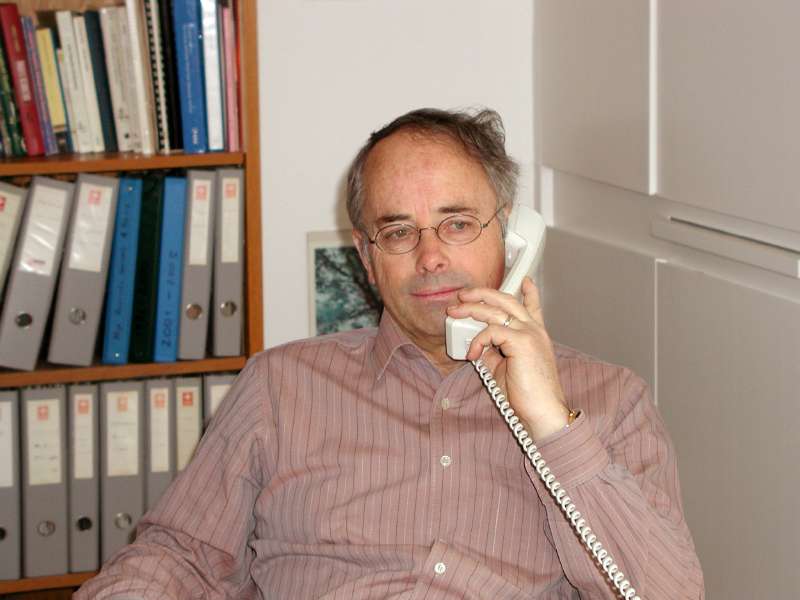Herschel studies star formation
The “Herschel First Results Symposium” taking place from 4 to 7 May 2010 in the Dutch town of Noordwijk will present initial results from just under one year’s worth of data measured by the Herschel Space Observatory. Arnold Benz, Professor at the Institute for Astronomy of ETH Zurich, and his team will also present their first results at the symposium: they identified ionized water using spectral lines. Previously, the team had already used its calculations to postulate that this would have to be formed during the birth of stars.

Mr. Benz, what are the aims of the billion-euro “Herschel”
project?
Equipped with three
different measuring instruments, Herschel is the first observatory that can
study wavelengths from the infra-red to the millimetre regions. These wavelengths
cannot penetrate the Earth’s atmosphere because it contains too much water
vapour, so we cannot measure them from the ground. Our group has specialised on
one of the main topics in this region: the formation of stars and planets. In
this regard, we are primarily interested in water, which is detectable only via
this wavelength range.
Why water in particular?
Water is an important
and exciting molecule in the universe. We want to know how it is formed in cold
cloud nuclei during star formation. That could reveal to us how water arrived
on Earth. It is also an important marker in the various stages of star
formation.
You have now succeeded in a short time in achieving one
of your objectives in the Herschel project.
Via the absorption
spectrum of the spectral lines in the HIFI (Heterodyne Instrument for the Far
Infrared), we made measurements in the constellation of Perseus and detected
water in the temperature range from -170 degrees Celsius to 1,200 degrees
Celsius during star formation. At present we can distinguish two phases of
formation: below -170 degrees Celsius, water forms by oxygen and hydrogen
attaching to dust particles and combining to form water through a catalytic
reaction. If the star warms up during its formation, a very large amount of
water – ionized – then forms suddenly at -20 degrees Celsius.
How is this water formed?
Carbon monoxide
present in the proto-star’s envelope is split into carbon and oxygen by X-rays
and ultraviolet radiation. Each free oxygen atom then combines to form water. This
is around 10,000 times more abundant than catalytically generated water. It is
astonishing how easily water can be found in the proximity of emerging stars.
How is ionized water formed?
A proportion of the
oxygen atoms can also be ionized during the splitting process. Ionized water is
then formed. We were completely astonished at how much of it is formed in this
phase.
You had predicted that you would find this kind of
water with Herschel.
We carried out
calculations in advance, which was why we suspected we would also be able to
use the HIFI to detect the fourth phase of water, i.e. ionized water. However,
it was not clear to us beforehand that, in the early stage of development, we
already have the high-energy radiation that is responsible for forming this
kind of water.
What progress have you made with the Herschel project so
far?
We had rather bad
luck at the beginning: a cosmic ray particle triggered a fault signal in an
electronic control unit, causing the instruments to switch off suddenly. That
caused a current surge which destroyed part of the measurement electronics. Fortunately,
there was a back-up unit for this, which we were able to activate in January. Everything
has gone very well for us since then.
What will be the next step?
Our long-term
objective is to characterise the high-energy radiation and its ionizing effect,
and why and how it acts. By modelling the conditions precisely, we want to find
out why such a large amount of ionized water is formed and what happens in the
individual phases of star formation.
The Herschel telescope
After a planning and construction phase lasting 27 years, the Herschel Space Telescope flew to its destination, the second Lagrange point (L2), in May last year (see ETH Life of 14 May 2009. Herschel is equipped with three measuring instruments, parts of the Heterodyne Instrument for the Far Infrared (HIFI) having been developed at the Institute for Astronomy and the Electromagnetic Fields and Microwave Electronics Laboratory of ETH Zurich. It is used to measure the far infra-red radiation with which the researchers have now been able to prove that water is formed during star formation in cold cloud nuclei. After a 1.5 million kilometre journey lasting three months, the telescope has since been sending data to the ESA ground station near Madrid. The first of the evaluated data is to be published in about 200 articles in the scientific journal “Astronomy and Astrophysics” in the summer of this year.








READER COMMENTS